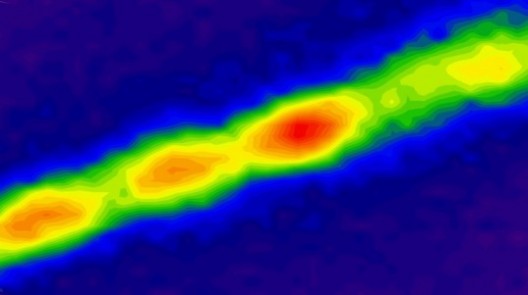In some exciting news that could make several quantum leaps in solar cell performance, Massachusetts Institute of Technology researchers have announced a hundred-fold increase in light gathering capabilities for solar cells. If a cell were able to exploit this increase, an aircraft such as the Solar Impulse could fly on 120 solar cells instead of the 12,000 now spread across its over 200-foot wingspan.
We’ve reported on carpet-like light-capturing formats for increasing solar cell output, but the MIT approach funnels light down a multi-carbon nanotube filament, boosting the output of the “tiny” solar cell at the bottom.
MIT’s press release explains the outcome. “’Instead of having your whole roof be a photovoltaic cell, you could have little spots that were tiny photovoltaic cells, with antennas that would drive photons into them,’ says Michael Strano, the Charles and Hilda Roddey Associate Professor of Chemical Engineering and leader of the research team.

This filament containing about 30 million carbon nanotubes absorbs energy from the sun as photons and then re-emits photons of lower energy, creating the fluorescence seen here. The red regions indicate highest energy intensity, and green and blue are lower intensity. Image by Geraldine Paulus
“Strano and his students describe their new carbon nanotube antenna, or ‘solar funnel,’ in the September 12 online edition of the journal Nature Materials. Lead authors of the paper are postdoctoral associate Jae-Hee Han and graduate student Geraldine Paulus.”

post-doctoral associate Jae-Hee Han, Geraldine Paulus, and Michael Strano with light-gathering filament. Photo by Patrick Gillooly
Their efforts involve exciting electrons into jumping between different bandgaps, essential to energy generation in solar cells, and explained here by the team. “The antenna consists of a fibrous rope about 10 micrometers (millionths of a meter) long and four micrometers thick, containing about 30 million carbon nanotubes. Strano’s team built, for the first time, a fiber made of two layers of nanotubes with different electrical properties — specifically, different bandgaps.
“In any material, electrons can exist at different energy levels. When a photon strikes the surface, it excites an electron to a higher energy level, which is specific to the material. The interaction between the energized electron and the hole it leaves behind is called an exciton, and the difference in energy levels between the hole and the electron is known as the bandgap.
“The inner layer of the antenna contains nanotubes with a small bandgap, and nanotubes in the outer layer have a higher bandgap. That’s important because excitons like to flow from high to low energy. In this case, that means the excitons in the outer layer flow to the inner layer, where they can exist in a lower (but still excited) energy state.
“Therefore, when light energy strikes the material, all of the excitons flow to the center of the fiber, where they are concentrated. Strano and his team have not yet built a photovoltaic device using the antenna, but they plan to. In such a device, the antenna would concentrate photons before the photovoltaic cell converts them to an electrical current. This could be done by constructing the antenna around a core of semiconducting material.”
Strano and his researchers have been busy on other aspects of exciting electrons, including running ions through nanotubes in single file, a feat that could lead to practical desalination processes, detection of impurities and toxic materials at extremely low (one ion) levels, and even development of practical fuel cells.
